
The Grand Canal is a channel in Venice, Italy. It forms one of the major water-traffic corridors in the city.

Palazzo Labia is a baroque palace in Venice, Italy. Built in the 17th–18th century, it is one of the last great palazzi of Venice. Little known outside of Italy, it is most notable for the remarkable frescoed ballroom painted 1746–47 by Giovanni Battista Tiepolo, with decorative works in trompe-l'œil by Gerolamo Mengozzi-Colonna.
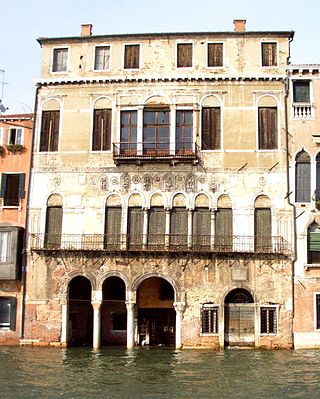
The Ca' da Mosto is a 13th-century Venetian-Byzantine style palace, the oldest on the Grand Canal, located between the Rio dei Santi Apostoli and the Palazzo Bollani Erizzo, in the sestiere of Cannaregio in Venice, Italy. Today, it is home to the Venice Venice Hotel.

Venetian Gothic is the particular form of Italian Gothic architecture typical of Venice, originating in local building requirements, with some influence from Byzantine architecture, and some from Islamic architecture, reflecting Venice's trading network. Very unusually for medieval architecture, the style is at its most characteristic in secular buildings, with the great majority of surviving examples of the style being secular.

Ca' Loredan Vendramin Calergi is a 15th-century palace on the Grand Canal in the sestiere (quarter) of Cannaregio in Venice, northern Italy. It was commissioned by the patrician Loredan dynasty, namely Andrea Loredan, and paid for by Doge Leonardo Loredan, with construction starting in 1481. The architecturally distinguished building was the home of many prominent people through history and was the place where composer Richard Wagner died.
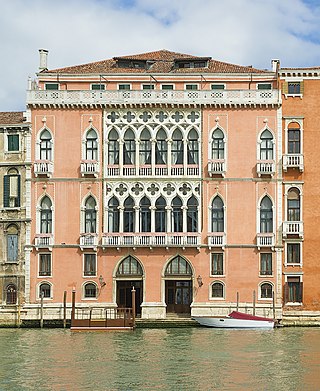
Palazzo Pisani Moretta is a palace situated along the Grand Canal in Venice, Italy, between Palazzo Tiepolo and Palazzo Barbarigo della Terrazza.
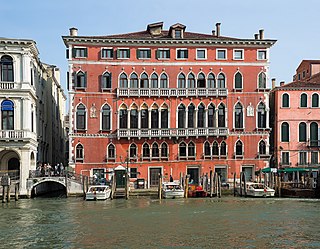
Palazzo Bembo is a palace in Venice, Italy, on the Grand Canal, close by the Rialto Bridge and next to the Palazzo Dolfin Manin.

The Palazzo Ferro Fini is a historical building in Venice, Italy. It was originally two buildings, the Palazzo Morosini Ferro and the Palazzo Flangini Fini, which were combined into one in the 1860s to create the luxury Hotel New York. The hotel was occupied by troops in World War II (1939–45). By 1970 the hotel was in decay, and the building was purchased by the Veneto region, which undertook extensive renovations and made it the seat of the regional council.

The Palazzo Manfrin Venier, once known as the Palazzo Priuli a Cannaregio or Palazzo Priuli Manfrin, is a Baroque-style palace located facing the Cannaregio Canal in the sestiere of Cannaregio of Venice, Italy. It stands to the left of the Palazzo Savorgnan.

The Palazzo Pisani Gritti is a Venetian Gothic palazzo located on the north side of the Grand Canal, opposite the Church of the Salute, between the Campo del Traghetto and the Rio de l'Alboro, in the Sestieri of San Marco, Venice, Italy. It was the residence of Doge Andrea Gritti in the 16th century. It is now the Gritti Palace Hotel.

Palazzo Nani is a Renaissance palace in the Cannaregio district of Venice, Italy.
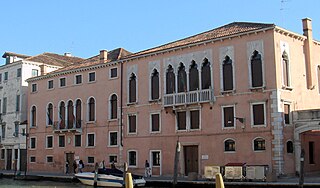
Palazzo Testa is a small Gothic palace in Venice, Italy, located in the Cannaregio district and overlooking the Canale di Cannaregio.
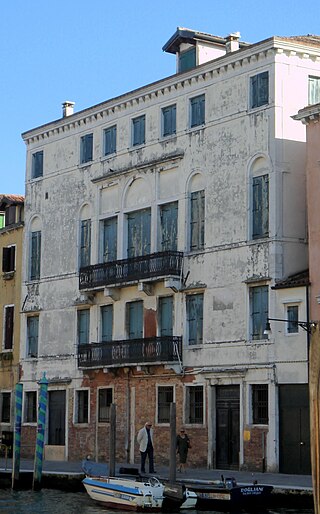
Palazzo Bonfadini Vivante is a palace in Venice, Italy located in the Cannaregio district and overlooking the Cannaregio canal. The neighboring buildings are Palazzo Savorgnan and Palazzo Testa.

Palazzo Correr Contarini Zorzi is a Renaissance palace in Venice, Italy, overlooking the Grand Canal and locating in the Cannaregio district between Palazzo Querini Papozze and Palazzo Gritti. The palazzo is also known as Ca' dei Cuori, a family whose wrought iron coats of arms is present on the façade.

Palazzo Civran Grimani is a Neoclassical palace in Venice, Italy. The palazzo is located in the San Polo district, overlooking the Grand Canal at the confluence with Rio della Frescada, between Palazzo Dandolo Paolucci and Palazzo Caotorta-Angaran.

Palazzo Giustinian Pesaro is a Gothic palace located in Venice, Italy, in the Cannaregio district and overlooking the Grand Canal. The palazzo is situated between Ca' d'Oro and Palazzo Morosini Sagredo.
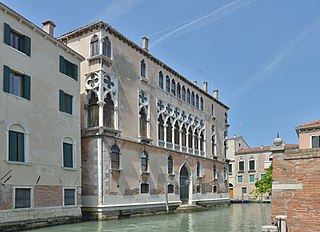
Palazzo Donà Giovannelli is a civil building located in the city of Venice, Italy in the Cannaregio district. The palace neighbors Palazzo Pasqualigo Giovannelli and overlooks the Rio di Noale and the Rio di Santa Fosca.
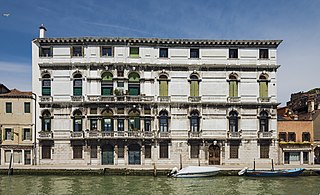
Palazzo Surian Bellotto is a Baroque palace in Venice, Italy. The palazzo is located in the Cannaregio district and overlooks the Cannaregio Canal.
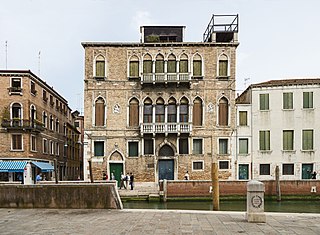
Palazzo Barbarigo Nani Mocenigo is a Gothic palace in Venice, Italy located in the Dorsoduro district, along the Nani embankment on the San Trovaso canal, near the Campo San Trovaso.

Palazzo Bolani Erizzo is an ancient Venetian palace of the 13th century, built along the Grand Canal in the Cannaregio district. It stands wall to wall with Palazzo Dolfin.




















